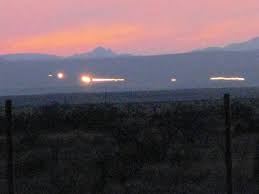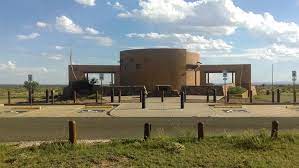 by Charles Lear, author of “The Flying Saucer Investigators.”
by Charles Lear, author of “The Flying Saucer Investigators.”
In Marfa, Texas, there is a phenomenon known as “The Marfa Lights” that has been around for a long time and still remains a mystery. It’s been studied by members of the Society of Physics Students from the University of Dallas and a retired aerospace engineer, James Bunnell. The students thought people were seeing car headlights on U.S. 67. Bunnell thought there was more to the lights than mere misidentification.
According to the Texas State Historical Association website entry on the subject by Julia Cauble Smith, the first historical record of a mystery lights sighting dates back to 1883. According to Smith, Robert Reed Ellison, a young cowhand, saw a flickering light while driving cattle through an area known as Paisano Pass and thought it might be coming from an Apache campfire. Other settlers told him they had seen lights on other occasions and when they investigated, they found no signs of fires in the area. This has been used as an argument against the car lights on U.S. 67 explanation by defenders of the mysterious nature of the lights, such as Ariel Slick, who posted an article on the Deep South Magazine website headlined “Marfa Lights: The Spirit of Texas” on August 19, 2022.
A reporter who claims to have actually seen the lights himself is Michael Hall, who wrote an article headlined “The Truth is Out There” posted in June 2006 on the Texas Monthly website. Hall describes the lights as yellowish lights that would glow, fade, disappear and reappear in different places, sometimes changing colors or splitting apart. Other witnesses he refers to in his article describe them as sometimes moving upwards.
Hall reports that he has visited Marfa on several occasions and did so for the article. As part of his research, he contacted Ellison’s granddaughter, Rosemary Cox. He wrote that she told him that Ellison had spoken to his family about seeing the lights, but when looking through Ellison’s 1937 memoir provided by Cox, he saw no mention of them.
 Hall mentions another historical source, O.W. Williams, cited by “the State of Texas.” O.W. Williams was the grandfather of Clayton Williams, who was a Texas businessman dealing in oil, gas, real estate, and other ventures who ran for governor in 1990. Williams told Hall that his grandfather had a Mexican guide who told him campfire stories told to other Mexicans by the Indians, and these included one about the lights. According to Williams, his grandfather wrote some of the stories down, but not the one about the lights. Williams did, however, say that his grandfather told him “about seeing them.”
Hall mentions another historical source, O.W. Williams, cited by “the State of Texas.” O.W. Williams was the grandfather of Clayton Williams, who was a Texas businessman dealing in oil, gas, real estate, and other ventures who ran for governor in 1990. Williams told Hall that his grandfather had a Mexican guide who told him campfire stories told to other Mexicans by the Indians, and these included one about the lights. According to Williams, his grandfather wrote some of the stories down, but not the one about the lights. Williams did, however, say that his grandfather told him “about seeing them.”
The earliest record Hall could find that was not purely anecdotal was an article in the February 9, 1945 San Angelo Times headlined “Ghost Light Appears in Marfa Area.” This is more than a decade before an article by Paul Moran in the July 1957 edition of Coronet magazine headlined “The Mystery of the Texas Ghost Light” that is cited in many accounts, including the Wikipedia entry, as the earliest written record.
 A comprehensive website devoted to the lights is Marfa Lights Mysteries, run by Robert and Judy Wagers, who wrote a book published in 2012 titled Mysteries of the Marfa Lights Revealed. Included in the history section of the website is a summation of the San Angelo Times article. According to the summation, two Army airmen flew towards the Chinati Mountains in an effort to locate the source of the lights but found they couldn’t see them from the air. As for the identity of the airmen, it is reported that Elton Miles, author of the 1976 book, Tales of the Big Bend, found one of them, identified as former MAAF flight instructor Lt. Fritz Kahl, and included his account in the book:
A comprehensive website devoted to the lights is Marfa Lights Mysteries, run by Robert and Judy Wagers, who wrote a book published in 2012 titled Mysteries of the Marfa Lights Revealed. Included in the history section of the website is a summation of the San Angelo Times article. According to the summation, two Army airmen flew towards the Chinati Mountains in an effort to locate the source of the lights but found they couldn’t see them from the air. As for the identity of the airmen, it is reported that Elton Miles, author of the 1976 book, Tales of the Big Bend, found one of them, identified as former MAAF flight instructor Lt. Fritz Kahl, and included his account in the book:
“I chased them in an airplane, not once but several times, and this was in 1943 and 1944. … there I was, a World War II aviator. … I was twenty-one years old and didn’t have any sense, flying airplanes at night out in the hills, right down to the ground.”
The paper produced by the students from Texas State is no longer available online. There is, however, an article that was posted on November 4, 2002, on the website of The Houstonian that quotes the team leader, Derek Buster. According to Buster, the lights “were a hoax.” He explained that the team analyzed the spectrums of the lights they saw through filters attached to a telescope and concluded that they were the same as that produced by a halogen bulb and that they were seeing car lights. He went on to say that Marfa and the State of Texas had used the phenomenon to promote tourism in the area. According to Hall, the students were only in Marfa for three days.
Marfa has, indeed, used the lights to promote tourism. There is the Marfa Lights Festival, which will be celebrating its 34th year this September, and there is a viewing area that was built in 2003 on U.S. 90. According to Hall, the town used $730,000 from the federal government and the Texas Department of Transportation to expand a small pull-off area.
However, contrary to Buster’s cynical comment, according to an article by Elettra Fiumi & Eliot Stein posted January 17, 2018, on the BBC website headlined “The Mysterious ‘Ghost Lights’ of Marfa, Texas,” the person who first promoted the lights as a tourist attraction was Armando Vasquez, 92 years old when the article was written, who claimed to have seen the lights in 1971. He began taking people from the two hotels in Marfa out to “a dusty bluff” to see the lights. According to him, “For years, we didn’t have anyone here except the people who wanted to see the lights. I was afraid Marfa would turn out to be a ghost town, but this was very good because it helped to keep our town alive.” According to the article, Vasquez petitioned the Marfa Chamber of Commerce “for years” to promote the lights and it wasn’t until 1986 that they put together the first annual Marfa Lights Festival.
A person who has studied the lights extensively is James Bunnell, a retired NASA aerospace engineer who wrote four books on the subject. According to Bunnell on his website, he first became intrigued by the lights in November of 2000. He set up ten automated video cameras and “recorded every night for many years.” He describes his investigation this way: “Data collection using automated cameras was supplemented with 288 nights of onsite observations using telescopes with single lens reflex cameras as well as many types of sensors.” His opinion is the same as that of others in Marfa referred to by Hall who wrote, “It took me ten years, but I was finally let in on the little secret shared by locals and old-timers: There are two kinds of Marfa lights, the real ones and, well, the phony ones, the ones you see from the viewing center.”